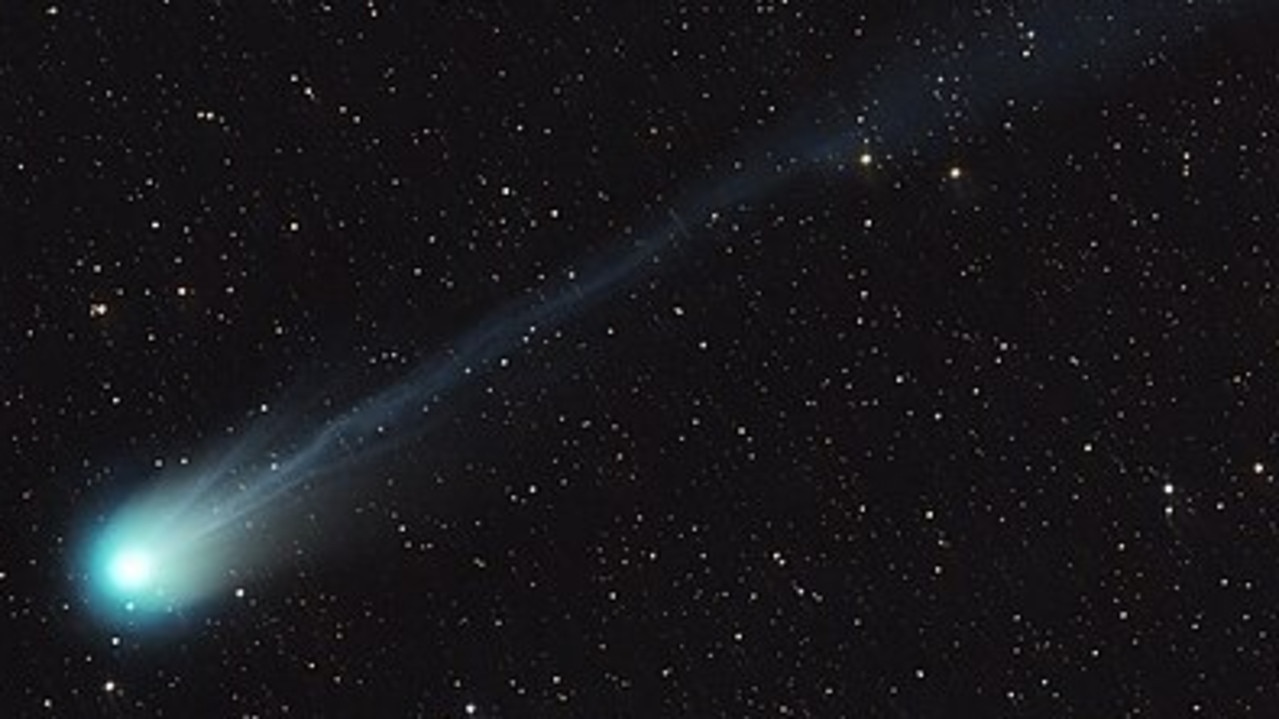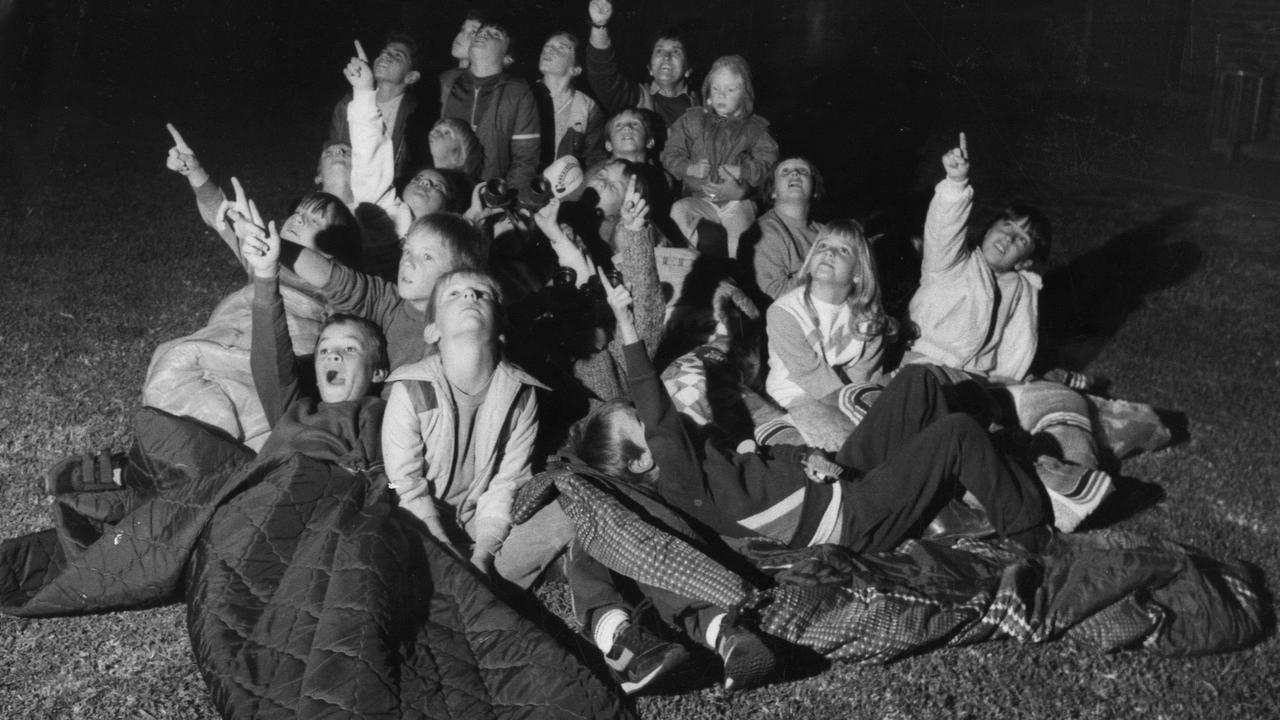‘Won’t be back for 71 years’: How you can see the rare Devil’s Comet in Australian skies
It’s been more than seven decades since Australians have viewed the bright green Devil’s Comet in our night sky. Here’s how and where you can see it over coming weeks

READING LEVEL: GREEN
America may have just had its mania*-causing solar eclipse*, but Aussies have a Devil’s Comet.
If you’re a stargazer* hoping to catch a glimpse of the rare comet, the tip from experts is avoid the big cities and find an area with clear skies in the country.
The comet, officially known as Comet 12P/Pons-Brooks, is made up of mostly ice, rock, gas and dust and will make its way across our skies in coming days.
Dr Rebecca Allen from Swinburne’s Centre for Astrophysics* said the brilliant green comet would continue to brighten from April 22 for a few nights.
“Look towards the western horizon* near sunset for a nice pairing with Jupiter. I recommend binoculars to spot the comet, given it appears at dusk,” she said.

Associate Professor Michael Brown, an astronomer* at Monash University’s School of Physics and Astronomy, said comets were among the most fascinating and at times spectacular astronomical objects.
“(They are) fleeting visitors to the inner solar system with tails of gas and dust stretching millions of kilometres across space. Comet Hyakutake stretching across the night sky is vivid* in my mind despite it being decades ago,” he said.
This week, when the Devil’s Comet is closest to the sun, is when the most heat will be on the comet and cause the ice to turn to a gas — which is what we see glow around the comet.
Assoc Prof Brown said there have been some beautiful images of the Devil’s Comet recently but they were taken with sensitive cameras and telescopes.
“Unfortunately, (it) will appear faint and fuzzy to the unaided* eye, although better views will be possible with binoculars and small telescopes. The best views will be in the country, away from light pollution,” he said.

University of Southern Queensland’s Professor Jonti Horner warned the comet could be “far from spectacular” this week after it had spent “seven decades in the icy depths of the solar system”.
An astronomer and astrobiologist*, Prof Horner said the Devil’s Comet would gradually get higher in the evening sky over the next few weeks, as it very slowly faded.
“So the best time to look for it might actually be in the first two weeks of May. Search for it with binoculars, after the sun has set, and once you’ve found it, then see if you can spot it with the naked eye.”
CSIRO astronomer Vanessa Moss said any celestial* event was a reminder of “our place in the universe”.
“It’s definitely worth taking the opportunity to try spotting it — it won’t be back for another 71 years,” she said.
FAST FACTS
How old is it?
The Devil’s Comet has been observed since the 1800s and was first discovered by Jean-Louis Pons on July 12, 1812 and then independently rediscovered by William Robert Brooks in 1883. It is a Halley group comet because, similar to Halley’s comet, it’s only seen once every 70 years.

Why is it called the Devils’s Comet?
It got its nickname thanks to its explosive nature.
“When it was first spotted coming into the inner solar system, it was very volatile*, which means it had been having all these big eruptions of ice and gas and dust,” Dr Allen said.
“So it got this very peculiar shape, where it almost looked like it had a double tail forming with some horns that were trailing off the back of it,” she said.
What colour and size is it?
This comet glows green, not red like a devil, with a tail shooting off. It’s also very large, measuring up to 10km wide and 17km long.

Where is the best place to see the comet?
Find a location in a country area that is flat, has a view of the horizon, little to no trees and reduced light pollution (such as street lights and lights from buildings).
How far away is it?
At its closest, the Devil’s Comet will be 230 million kilometres away from Earth.
“That’s actually further than the distance from Earth to the Sun. So it’s going to remain quite far away from us, well beyond any distance we would be worried about,” Dr Allen said.
POLL
GLOSSARY
- mania: extreme enthusiasm
- solar eclipse: when the Moon moves between Earth and the Sun and the daytime sky goes dark
- stargazer: someone who views stars
- astrophysics: the science of collecting particles from meteorites and using telescopes on land, in balloons, and in satellites to gather data about space
- horizon: the line where the earth or sea seems to meet the sky
- astronomer: a scientist who studies the objects in the sky, including planets, galaxies, black holes, and stars
- vivid: very bright
- unaided: without assistance
- astrobiologist: an expert who studies the origin and evolution of life on Earth, searches for alien life, and examines how outer space affects living organisms
- celestial: relating to outer space
- volatile: explosive
EXTRA READING
Millions pause to see rare solar eclipse in US
What time is it on the Moon?
Headaches hurt differently in space
QUICK QUIZ
1. Why is the comet named after a devil?
2. What colour does it appear and how big is it?
3. When was the Devil’s Comet first seen?
4. What is special about a Halley group comet?
5. How far from Earth will the comet be when Australians view it?
LISTEN TO THIS STORY
CLASSROOM ACTIVITIES
1. Use Your Senses Visualisation Exercise
Find somewhere comfortable to sit in the classroom that’s quiet and your own space. Get your body comfortable and close your eyes allowing your eyes to rest. Think about the article you just read on the Devil’s Comet.
What questions do you have? What part of the article most caught your attention? What did you find interesting?
Now, visualise yourself laying somewhere serene, in the middle of nowhere, gazing at this almost dark dusk sky, after sunset when the comet becomes visible.
Imagine you are there, searching for the Devil’s Comet in the dark but sparkling sky.
- What do you see?
- What do you hear?
- What can you feel?
- What can you smell?
Stay serene and relaxed for a few minutes longer visualising the comet.
Record your senses on a piece of paper to share aloud.
Time: allow 20 minutes to complete this activity
Curriculum Links: English, Science, Personal and social, Critical and creative thinking.
2. Extension
What year will the next sighting of the Devil’s comet be?
How old will you be then?
What sort of technology might you or your children be using then to view the comet?
Time: allow 10 minutes to complete this activity
Curriculum Links: English, Science, Personal and social, Critical and creative thinking.
VCOP ACTIVITY
1. Opener up-level it
Make a list of all the openers in the article. Pick three that repeat and see if you can replace them with another word, or shuffle the order of the sentence to bring a new opener to the front.
Don’t forget to re-read the sentence to make sure it still makes sense, and that it sounds better.

